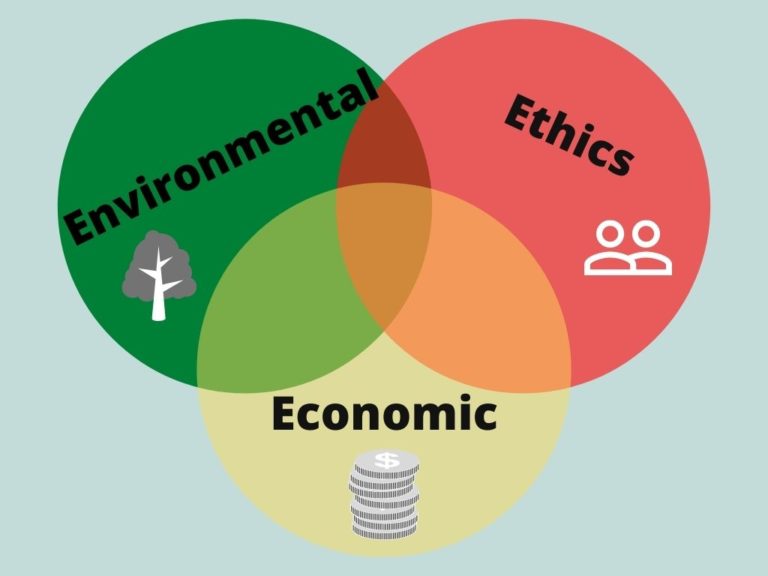Sustainability and Diversity, Equity, & Inclusion (DEI): what is the link?

The term sustainability and sustainable development are being used often these days by businesses, governments, countries, influencers, futurists, and so on. It has been designated as a megatrend in many noticeable publications, while the whole world is trying to achieve the United Nations Sustainable Development Goals by 2030. However, in all the talk about sustainability, have you ever wondered what is the connection between Sustainability and Diversity, Equity, & Inclusion (DEI), in the world and in your organization?
In this blog, we will discuss how Diversity, Equity & Inclusion (DEI) are the missing link to all our sustainability efforts. But, before diving any further into the topic, let’s first understand what sustainability means. There are many definitions describing sustainability, but the most common one is based on the Bruntland report (1987). According to it, sustainability is:
“Development which meets the needs of current generations without compromising the ability of future generations to meet their own needs.”
In simple words: how we live today impacts the ability of our future generations to lead a good life. Our planet has many resources, some are finite while others can be replenished; however, in today’s scenario, even our replenishable resources are depleting due to over consumption. Through sustainable practice we understand how to use our resources responsibly with a view to long-term consequences.
With this understanding, we could say that sustainability is about our resources and is mostly concerned with environmental issues. Therefore, often sustainability is interchangeably used for environmental sustainability. However, it is much more than that and can be explained by the concept of 3Es.
3Es stand for environmental, economic and ethical (also referred to as equity or social). Only a balance between all these three aspects could lead to sustainable development.

This concept has been defined by different researchers in different ways, like the three interconnected ‘sustainability pillars’ (Basiago 1999; Pope et al. 2004; Gibson 2006; Waas et al. 2011; Moldan et al. 2012; Schoolman et al. 2012; Boyer et al. 2016), ‘stool legs’ (Dawe and Ryan 2003; Vos 2007), ‘aspects’ (Goodland 1995; Lozano 2008; Tanguay et al. 2010), ‘perspectives’ (Brown et al. 1987; Arushanyan et al. 2017), etc. However, the main idea in all these definitions is to depict a balance between environmental, economic and social factors.
Understanding this concept is crucial for the companies that are on a journey to create sustainable businesses. Those who are still unsure about why they should invest in sustainability will soon be forced to do so, either by government policies or with the raising awareness among the customers. As per the CGS’s 2019 Retail and Sustainability Survey, 68% of consumers regardless of age and gender agrees that product sustainability is important for them. One-third of consumers are ready to pay 25% more for sustainable products, and Gen Z is willing to pay 50-100% more compared with other age groups. This is an attractive statistics for the companies, as Gen Z comprises 32% of the global population (approx. 2.5 billion), surpassing the population of Millenials and Baby Boomers in the world. (Toyota 2018)
Sustainable companies can also benefit from huge competitive advantages, higher returns, and longer lifespans. The Global 100 ranking of the world’s most sustainable companies by Corporate Knights shows that performing well on sustainability not just makes you money, but it also helps the business to live longer. Analysis of these companies shows that the average age of a Global 100 company is 87 years, while the average age of companies in the MSCI (Morgan Stanley Capital International) All Country World Index (ACWI) is only 63 years. (Strauss 2019)
Many companies have already identified the benefits of shifting towards sustainable practices. Kering Group, a French luxury brand with 60% women on their executive boards, is referred to as one of the most sustainable luxury brands in the world and has been on the Global 100 list for years. Kering was also ranked fourth in the top 100 luxury goods companies by sales in 2019. Neste, a Finnish energy company, has been ranked the third most sustainable company in the world consecutively for the third time. Until recently, Neste was a fossil fuel company but now the firm shifted to greener alternatives and has witnessed a 300% rise in their share prices in the last five years (Strauss 2019).
In addition, these days more and more investors screen their potential investments based on ESG (Environment, Social, and Governance) or SRI (Socially Responsible Investment) score (Beattie 2021). These metrics are used to measure a company’s sustainable footprint. Environmental criteria consider how a company performs in terms of nature. Social criteria examines how it manages relationships with employees, suppliers, customers, and the communities where it operates. Governance deals with a company’s leadership, executive pay, audits, internal controls, and shareholder rights.

As stated by Morgan Stanley in an Institute for Sustainable Investing report,
“Increasingly proactive, they [individual investors] seek products and solutions across asset classes tailored to their interests. They also want to measure the environmental and social impact of their investments”
Europe has traditionally been the leader in ESG (Envrionment, Social, and Governance) but now the other parts of the world are catching up quickly. As per the Global Sustainable Investment review 2020, Canada is now the market leader with the highest proportion of sustainable investment assets at 62%, followed by Europe (42%), Australasia (38%), the United States (33%), and Japan (24%).
With all this data in place along with many positive stories from companies shifting towards sustainable practices, it is safe to say that sustainability and Diversity, Equity, & Inclusion (DEI) are the way forward for not just the companies, but for humanity as a whole. However, the companies still lack the complete understanding of the concept by focusing only on the economic and environmental aspects of it. The importance of the social or ethical aspect of sustainability is often overlooked. Going ahead in this blog, we will talk about how the concepts of Sustainability and Diversity, Equity, & Inclusion (DEI) are strictly intertwined and must be address together when implementing a sustainability strategy.
Let’s now examine the 3 E’s of Sustainability in more detail and see how Diversity, Equity & Inclusion (DEI) can be an asset for organizations in order to have a better ESG score; this would make them more attractive to investors and customers, while also being a responsible entity of the society.
E #1: Environment
This is the most discussed aspect of sustainability. Companies are making huge efforts to reduce their carbon footprint, waste, water usage, non-environmentally friendly packaging and the overall negative impact on the environment. In order to achieve reduced carbon footprint, companies must consider their global operations, supply chain, factory or office locations, communities they operate in, and so on. To succeed in this task, they must effectively communicate and collaborate with individuals from diverse backgrounds and expertise.
A diverse, equitable, and inclusive workplace improves the environmental impact of a company. Here are some ways of how it can be achieved:
- Equity and inclusion helps create equitable and inclusive processes: To successfully optimize the organization, it is important to include all the stakeholders and create processes that will enable each individual with the support they require. Without processes that include everyone and support individual needs, the company will miss out on a considerable segment of stakeholders participation.
- Inclusive leaders possess higher cultural intelligence and skills to manage diversity: To improve the environmental footprint of a company, leaders need to effectively communicate with many individuals from different backgrounds, externally as well as internally. It is essential for them to understand how to manage diverse teams and possess cultural intelligence to succeed in their goals.
- Diversity helps build better strategies: Having employees representing communities or locations the company operates in helps to better understand the positive or negative impact on the surroundings by the company’s operations, this builds more trust and helps companies to build better strategies to support them.
- Diverse teams are more innovative and better prepared to take bold actions: Environmental efforts often require bold actions like rethinking the product design, supply chain, changing behaviours within the organization towards more sustainable choices. It has been proven that ethnic & gender diverse companies are 20% more innovative and 35% more likely to outperform homogenous teams (McKinsey, 2017); when the time comes to take bold actions and solve challenges, diverse teams are simply more prepared.
E #2: Ethics (Equity/Social)
Ethis is, unfortunately, one of the most overlooked aspects while developing sustainable strategies. Ethics is measured by the concept of social license, meaning that the company and its measures should be supported by its employees, stakeholders, and the community it operates in. To have an ethical social impact, companies need to work on treating their employees fairly, promoting no discrimination policies, supporting flexible working hours, investing in local communities, implementing fair wages, ethical sourcing, understanding the supply chain, and so on.
A diverse, equitable, and inclusive workplace improves the ethical or social impact of a company. Here are some ways of how it can be achieved:
- Promoting Equity in the company, ensures that everyone has access to the same opportunities and treatment. It also enables each individual to participate fully in the company’s sustainability efforts. Employees feel valued and heard, therefore, they are much likely to support the measures of the company, and work towards a shared goal.
- Inclusion leads to conscious decision making: Leaders who understand the dynamics of inclusive leadership and are aware of their own unconscious bias and privilege, make more conscious and fair decisions.
- Inclusive workplaces have better psychological safety: Feeling safe is one of the key human requirements to perform efficiently. When employees feel safe within the company, they can bring their authentic selves to work, share vulnerabilities without fear of repercussions and are not afraid to fail. Thus, increasing the team performance, risk-taking ability and overall employee satisfaction level.
- Diversity and Inclusion help the company reach a wider audience and avoid discriminatory pitfalls: Having people from different backgrounds and including minority stakeholders gives the company an insight into the untapped markets, helps identify discriminatory (for example, racist or sexist) products, services marketing campaigns or practices; making the company a responsible brand for its customers and employees.
E #3: Economic
The economic aspect of sustainability is not just about being profitable, but also about having good governance within the company. This means that the management and other stakeholders like end-users, value chain, etc. are aligned on common interests. The company is transparent and avoids conflict of interests.
A diverse, equitable and inclusive workplace improves the economic impact of a company. Here are some ways of how it can be achieved:
- Diversity with inclusion is profitable for the business: Well-managed culturally diverse boards worldwide make 43% higher profits than homogeneous boards. This shows a direct correlation of why diversity is profitable for the business.
- Inclusive organizations promote transparency: Inclusive organizations promote equal opportunities and a safe space for everyone, this ensures transparent communication leading to good governance.
- Teams with higher empathy are better equipped to deal with conflict of interests and confrontations essential to maintain a fair governance and strong leadership.
- Diverse and inclusive teams promote a trustworthy brand image: More diversity and representation within the company means that it is better able to understand different opinions from stakeholders, end-users, value-chain, customers etc. It is, therefore, easy to maintain trust and gain support from others.
To summarize, it is clear how Sustainability and Diversity, Equity & Inclusion (DEI) are strictly intertwined. The first step towards implementing a sustainability strategy is to ensure you work on providing your people a workplace where they can be themselves and contribute to their best abilities. Inclusive workplaces ensure that employees have a safe environment to undergo big structural changes and behavioral shifts, turning your sustainability efforts into success.
About the author:

Priyanka Banerjee is the CEO and co-founder of BusinessWiz, a company helping organizations create a sustainable, diverse, and inclusive workplace culture in the Nordics. Her background in engineering and her experiences in the tech industry inspired her to become an entrepreneur. Through her work with BusinessWiz and as an international speaker she aims to help tech organizations understand their existing company culture, provide them with tools to use diversity and inclusion as a competitive advantage, and help them create a future-proof organization.
Priyanka’s LinkedIn profile.